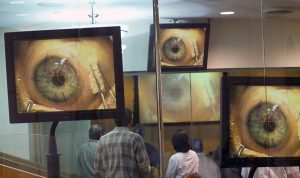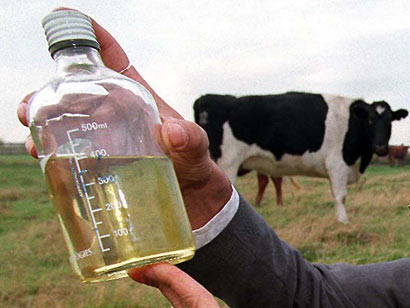In the summer of 1985, I was working in a cool lab, and about to enter the final year of my undergraduate degree in molecular biology and genetics.
In Aug. 1985, we got tickets to go see Neil Young and the International Harvesters at the CNE (the Canadian National Exhibition, or the Ex) and I fell ridiculously ill.
I was in bed for two weeks, barfing, and in agony – a great way to start a new relationship that would bear four beautiful daughters.
I made it out of bed to see Neil and the Harvesters.
The next day I went home to Brantford, Ontario, Canada.
I was really, really sick, my eye really, really hurt, and my parents suggested I go see the eye doctor.
Within 5 minutes, he diagnosed eye Herpes, prescribed a retroviral cream, and I was quickly cured.
Yeah, science.
I have been exceedingly public about this story in the fantastical hope that others may be spared some of the pain, or at least have it contained.
Sarah Zhang of The Atlantic writes – 33 years later – that Herpes simplex virus type 1 is best known as the culprit behind cold sores. When it’s not causing itchy, crusty sores on the mouth, it hides in the bundle of nerves that run through the face. And it’s super common. An estimated 50 to 90 percent of people harbor lifelong infections of HSV-1—largely without incident.
But in some cases, HSV-1 can run through that bundles of nerves in the face and erupt in the eye. Or maybe it gets into the eye from the outside. No one is really sure. In any case, HSV-1 can definitely infect the eye. (In case you’re wondering: HSV-1 can also cause genital infections, though it’s herpes simplex virus type 2 that is more commonly associated with genital herpes.)
Herpes in the eye is as bad as it sounds. The virus infects the cornea, forming tree-like branching ulcers across the eye. It can cause irritation, pain, sensitivity to light, and ultimately blindness if untreated. Herpes in the eye is a leading cause of blindness in the world. The cornea, after all, is a transparent layer of tissue at the front of the eye, whose job is essentially to let in as much light as possible. Infection can turn the cornea cloudy—permanently.
In most cases, herpes infections in the eye can be treated with antiviral drugs like Zovirax, but the herpes viruses are becoming increasingly resistant to these drugs. Scarred corneas can also be replaced with a transplant, but past infection makes the eye more likely to reject the new tissue. Plus, once you get herpes in the eye, it can keep coming back—just like cold sores. “For some patients that experience this, there’s absolutely nothing we do,” says Dan Carr, an HSV-1 researcher at the University of Oklahoma. “Essentially they’re going to go blind if something else doesn’t happen”—if new treatments don’t become available.
Enter now a surprising new study about herpes. Deepak Shukla, a virologist at the University of Illinois at Chicago, and colleagues have identified a molecule called BX795 that clears HSV-1 infections in human cells and in mice—with few side effects, it seems.
It’s a surprise because Shukla’s team originally threw BX795 onto HSV-1-infected cells thinking it would make the viruses grow better in the lab. (They were trying to study the virus’s basic functions.) That’s because BX795 is known to inhibit a enzyme called TBK1 that turns on the human immune response. Dampen the immune response, and you should get more viruses, right?
“We saw the opposite,” says Shukla. BX795 appears to play another role in yet another human enzyme that viruses hijack to synthesize their own viral proteins. Shukla’s team tested BX795 in cultured human cells, human corneas, and mice with herpes eye infections. It worked to suppress the herpes virus in all those cases—and often at lower concentrations than existing antiviral drugs.
Most exciting of all, BX795 could represent an entirely new class of drugs for herpes. Existing drugs generally work by inhibiting the virus’s DNA (or RNA) replication, blocking it from making more copies of itself. Since the drugs work in such similar ways, it’s easy for the virus to evolve resistance to all of them. “A second class is almost nonexistent. That’s where I think our discovery is really important,” says Shukla. BX795, remember, prevents protein synthesis instead. Shukla is now testing it to see if BX795 offers broad protection against other related viruses like those causing chicken pox and mono.
I spent the weekends of 1979 bagging rock, and while I thought I was just really bored, I had mono.


 4pm yesterday after some people reported irritation to their eyes, treating 30 people at the scene, AdelaideNow said.
4pm yesterday after some people reported irritation to their eyes, treating 30 people at the scene, AdelaideNow said.